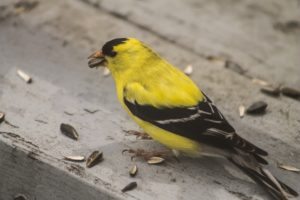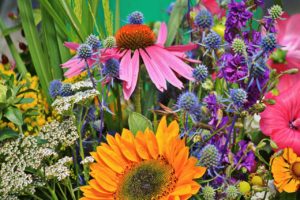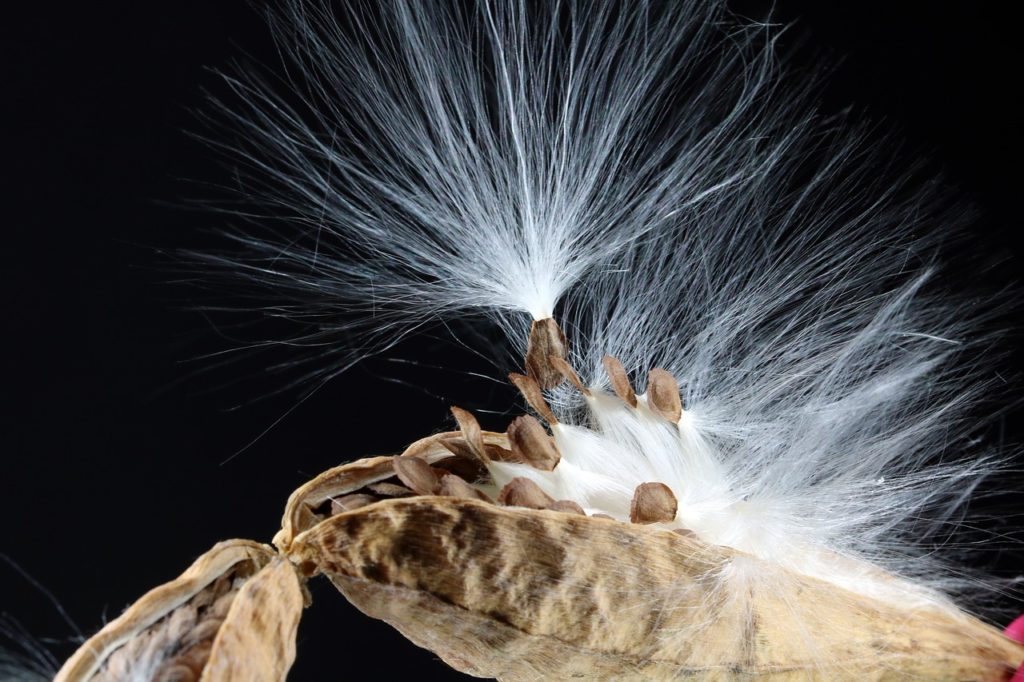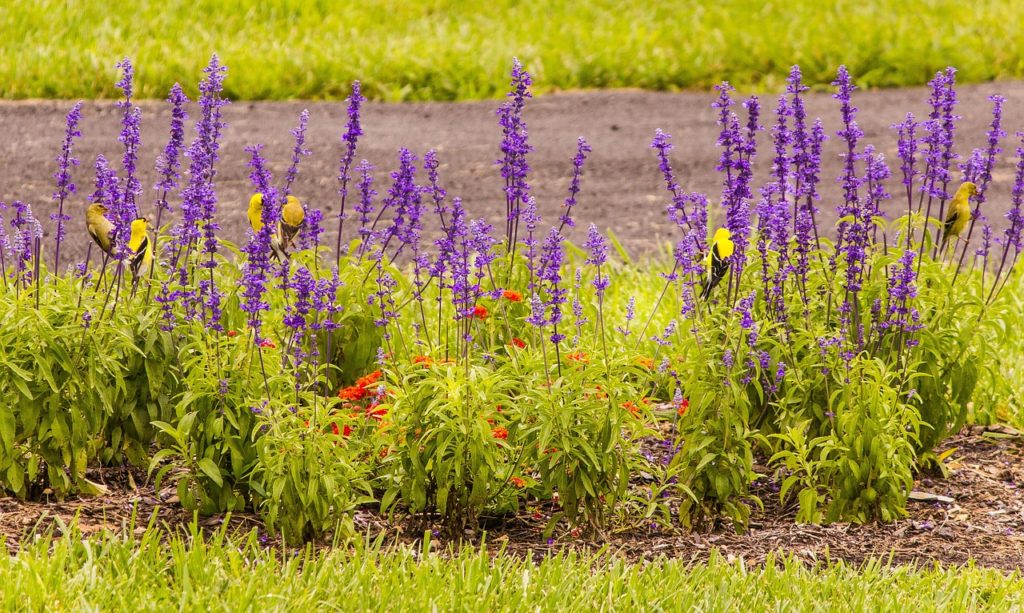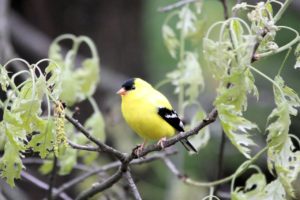Updated 7/12/2024
American Goldfinches and Basil
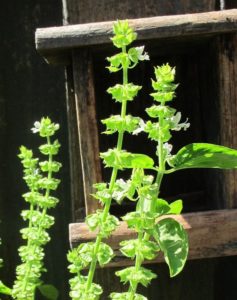
Basil ‘Genovese’ going to seed.
There’s been considerable excitement, lately, around the old basil plants on the deck. Flashy yellow American goldfinches have been flitting around the plants, landing near the tops of 4′ tall stems.
Normally, I would have cut the stems to prevent flowering, but the herb has had basil downy mildew. So I just let it go, curious to see who would show up. What a pleasant surprise to see the goldfinches move in for a feast of seeds!
Before the seedpods ripened, though, ruby-throated hummingbirds came for the white flowers’ sweet nectar. Almost like clockwork, these tiny marvels stopped by for their daily visits late in the afternoon.
Recently, I moved the big pot of basil to a sunnier place less than 10′ away. But the hummingbirds continued looking for the flowers in the old location. They hovered for a few seconds, and then flew away. The birds repeated this pattern for a few days until they rediscovered their treasure.
Memories from Childhood
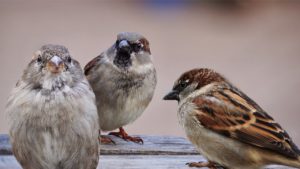
Sparrows.
We’ve been feeding birds all our lives, through the generations. I vividly remember my grandmother feeding the sparrows outside her kitchen door, and can recall the fevered chirps as they jockeyed for position and pleaded for more.
When my parents were dating, my mother’s green parrot bit right through my father’s fingernail.
Growing up, we always had a caged canary singing in the kitchen. And his name was always Tammy.
Before and after our own children were born, we kept various tiny chirpy finches, pairs of parakeets, and, for 20 years, a cockatiel named Narcissus. Narcissus was a rescue, and like my mother’s parrot 80 years ago, he never really warmed up to anyone else. For me, though—kisses, conversations, and a few bars of “We’re In the Army Now”. He sat on my shoulder, chuckling in my ear, between flights to the window for a peek outside.
Yes, we have an affinity for birds. Whether it’s bread crumbs, suet, pieces of fruit, peanut butter/seed pinecones, or bird seed from a bag…and water…our birds can count on us.
To the Rescue!
While growing up in Oradell, New Jersey, I often took in nestlings that fell from the neighbors’ trees. First I tried placing them back into their nests. At times there was nothing I could do; they were beyond help. And who knows? Maybe the parents pushed small or sickly birds out of the nests so they could concentrate on raising the rest of the brood.
Although not all the rescued chicks survived, I did my best to raise them to independence. Today, there are several organizations nationwide which will take orphaned animals.
Cedar Waxwings
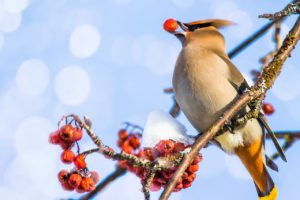
Cedar waxwing.
One year, I raised a beautiful cedar waxwing, which returned year after year, coming much closer than the rest of the flock. They fed on insects and berries, timing their migratory visits to coincide with the harvests.
Decades later, I occasionally witnessed a rare moment in the Rockville, Maryland back yard. A flock of perhaps 50 cedar waxwings gathered around and hovered over the small goldfish pond, chattering and dipping their beaks into the water. After only a few minutes of this hasty business, they were gone, off to warmer climes!
If I hadn’t peered out the kitchen window at just the right time, I would have missed it. We lived in that house for about 30 years, but I saw this activity only 3 or 4 times.
American Goldfinches
Migrations

The American goldfinch (Spinus tristus) spends its summer breeding season from North Carolina to Washington state, and north to parts of Canada. Its winter range shifts farther south, across the United States, except for the coldest regions of the northern states, and to parts of Mexico.
Populations will remain near stocked feeders in northern parts of their range if temperatures are above 0°F. Many migratory birds will hang around for the winter, and not head for warmer habitats, if food is readily and consistently available.
This sociable little finch travels in flocks, often in association with pine siskins and common redpolls. Peak migration seasons are mid-fall and early spring.
Its flight pattern is an undulating wave. The bird flaps its wings a few times, and then glides. It often chirps during flight while it flaps its wings, and is silent when gliding.
The American goldfinch is the state bird in New Jersey, Iowa, and Washington.
Habitat
American goldfinches are common in weedy fields, meadows, floodplains, and in open woods. They’re found among shrubbery, along roadsides, and around suburban residential properties. All season, they seek semi-open areas, trees, and dense evergreens for shelter and nesting.
The National Audubon Society reports that songbird populations are declining in most areas around the country. Habitat loss, using harsh chemicals, exotic plants displacing native species…these are some of the factors that take their toll. One practice that would help all seedeaters is simply letting plants remain in the garden after they’ve gone to seed.
Median Strips
When traveling several hundred miles north a couple of months ago, I noticed that miles and miles of the median strips, in Virginia and Pennsylvania, had been allowed to go “natural”. There were mature stands of wild “weeds” including milkweed, Queen Anne’s lace (wild carrot), goldenrod, ironweed, chicory, black-eyed Susan, grasses, and various asters. And there were lots of moths and butterflies, including monarchs, and American goldfinches, of course, feeding on the seeds.
It was quite a shock to see this about-face in landscape management style. Where mowers and machines previously had kept the near-sterile ground cover at a mere inch or two, these long stretches boasted complex systems of flowers and seedheads, saplings, and greenery in various stages of development…in other words, life!
Although this style of landscaping won’t appeal to everyone, I was happy to see nature catch a break. Maybe it’s time to adopt a new attitude…one that takes into consideration all organisms within an ecological system, seen and unseen. It’s time to look beyond aestheticism and to incorporate principles of sustainability if we’re ever to see a decline in population loss and extinction.
Food Sources
Perennials
American goldfinches forage in flocks, except while breeding. They prefer habitats we consider weedy, feeding on many plants in the Asteraceae family (the composites). That includes native perennials such as:
- globe thistle (Echinops)
- flodman’s thistle (Cirsium flodmanii)
- field thistle (C. discolor)
- cobweb thistle (C. occidentale)
- wayleaf thistle (C. undulatum). Thistle is their first choice. Check with your cooperative extension service to see if any of these native American species are considered invasive in your region.
- goldenrod (Solidago)
- ragweed (Ambrosia). This one—not goldenrod—causes late season hay fever.
- purple coneflower (Echinacea purpurea)
- New England asters (Symphiotrichum [formerly Aster] novae-angliae)
- cup plant (Silphium perfoliatum)
- Joe-Pye weed (Eutrochium, formerly Eupatorium)
- yarrow (Achillea millefolium)
- black-eyed Susans (Rudbeckia spp.)
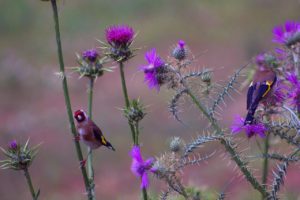
Thistle and European goldfinches.
More Perennials
- bee balm (Monarda)
- anise hyssop (Agastache foeniculum)
- lemon balm (Melissa officinalis). A patch of lemon balm grew outside the kitchen window when I lived in Maryland. In late summer, I let it go to seed for the American goldfinch. These agile acrobats grasped the 2′ stems, bobbing up and down while feeding on the seeds. American goldfinches apparently enjoy several plants in this family (Lamiaceae)—the balms, hyssop, basil, catnip, sage…
- the sages (Salvia spp.), annuals and perennials
- dandelion (Taraxacum)
- gayfeather, or blazing star (Liatris)
- western fescue (Festuca californica)
- yellow-eyed grass, blue-eyed grass (Sisyrinchium spp.)
- little bluestem (Schizachyrium scoparium)
- big bluestem (Andropogon)
- California field sedge (Carex praegricillis)
- common milkweed (Asclepias syriaca)
Goldfinches also feed on young twig bark, maple sap, and tree leaf buds.
Deadheading your plants—removing the aging seedpods—results in a tidier garden, but one that is devoid of goldfinches. So, if you enjoy watching these sprightly birds, allow at least some of your plants to go to seed. Other insects and animals also will benefit from a more casual approach to gardening.
Annuals

Zinnia angustifolia, the Star series.
Annuals that goldfinches feed on include zinnia, cosmos, daisies, salvia, marigold, poppies, and black-oil sunflowers. The American goldfinches are granivores, feeding almost exclusively on seeds. Consumption of insects is more accidental than it is intentional.
If you have an abundance of zinnia, cosmos, or sunflower seedheads, but prefer cleaning up the garden before planting the autumn pansies and violas, consider harvesting them after the seeds ripen. Save them in a cool dry place, where mice can’t reach them, for the autumn and winter feeders.
But don’t wait too long to first offer the seeds. You want to invite American goldfinches to stay before they migrate from the area. Once you start offering food, continue feeding them through winter.
Nyjer (Guizotia abyssinia, an herb of Ethiopian origin) and black oil sunflower seeds can be purchased from garden centers, hardware stores, warehouse clubs, and from specialty wildlife centers. Nyjer is grown in Ethiopia and Kenya, and is sterilized before importation. Often called “thistle”, this is an unrelated plant.
Trees and Shrubs
Ask your local Audubon chapter and other bird specialists for specific advice about native trees and shrubs that support populations of the American goldfinch. Some species that offer seeds and shelter include:
- elm (Ulmus americana). Look for varieties that are resistant to Dutch Elm Disease.
- American basswood (Tilia americana)
- hazelnut (Corylus cornuta)
- American beech (Fagus grandifolia)
- American sycamore (Platanus occidentalis)
- common witch hazel (Hamamelis virginiana)
- river birch, and other species (Betula spp.)
- western red cedar (Thuja plicata), and other arborvitae species
- white alder (Alnus rhombifolia)
- western redbud (Cercis occidentalis)
- common buttonbush (Cephalanthus occidentalis)
- island mallow (Lavatera assurgentiflora)
Greens
Goldfinches have been seen feeding on beet greens and on foliage of sunflowers and zinnias. Those evenly spaced V-shaped bites on the edges of Sedum leaves are due to birds seeking moisture and maybe nutrients. But I can’t yet definitively accuse the goldfinches of this practice.
Headings
Page 1: American Goldfinches and Basil, Memories from Childhood (To the Rescue!, Cedar Waxwings), Migrations, Habitat (Median Strips), Food Sources (Perennials, Annuals, Trees and Shrubs, Greens)
Page 2: Feeding American Goldfinches: To Feed or Not To Feed (On the Menu, Feeders, On Sunflowers), Weeds and Water, Nesting, Cowbirds, Other Goldfinches, a New Perspective In Gardening (Some Simple Fixes To Help American Goldfinches)
